Have you ever wanted to slay those spine-tingling blues solos that make an audience swoon? The secret weapon of many famous guitarists is mastery of the A minor blues scale. Here’s the story: I was once just like you, struggling to grasp the styles and patterns that could give my solos a soulful edge. But then, I stumbled upon this magical scale, and everything changed dramatically. However, what’s the twist? That’s something you need to stick around to discover.
I’m Robert Williams, a veteran guitar instructor with a deep obsession for blues scales. I’ve realized that an extensive understanding of this scale can unlock extraordinary guitar prowess. Are you ready to learn guitar scales that can shape your musical journey and redefine your style?
Let’s dive together into the incredible ocean of the A minor blues scale. This comprehensive guide will unravel this seemingly intricate scale, making it easy and fun to learn. Whether you aspire to play electrifying blues solos or seek to enhance your improvisation skills, you’ve hit the jackpot here! Let’s begin this thrilling journey together!
What is the A Minor Blues Scale?
Comparing the A Minor Blues Scale to the A Minor Pentatonic Scale
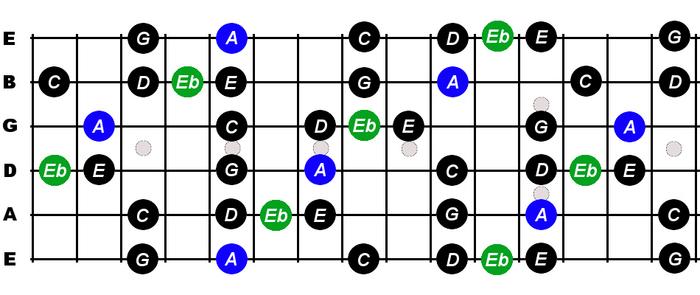
Building on our understanding of the A minor blues scale, it becomes imperative to notice its striking comparison with the A minor pentatonic scale, a difference that significantly shapes the tonal landscape of blues music. In my tenure at Acoustic Guitar magazine and through my personal explorations in guitar playing, the comparison and understanding of these two scales has been absolutely pivotal.
The A minor pentatonic scale, much like the blues scale, is a five-note scale composed of the tonic (A), minor third (C), fourth (D), fifth (E), and minor seventh (G). The beauty of the pentatonic scale lies in its simplicity, but the A minor blues scale takes this foundation and introduces a crucial element – the flat fifth, often referred to as the ‘blue note’.
This flat fifth (Eb in the A minor blues scale), creates a distinctive, pungent dissonance that’s iconic to the blues sound. The insertion of the blue note effectively raises the number of notes in the scale from five to six, providing additional melodic and harmonic possibilities that are at the core of Blues music.
Through this comparative analysis, it becomes transparent how the A minor blues scale uses the skeleton of the minor pentatonic scale as a springboard, introducing a single injection of ‘blues’ which profoundly alters its aural impression. This interplay and how it shapes the sound and soul of blues guitar, is what forms the following part of our exploration.
Where can you use the A Minor Blues Scale on the Guitar Fretboard?
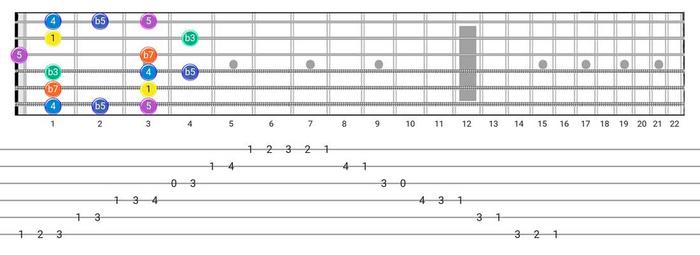
As a long-time guitar tutor, I have always found joy in aiding students to overcome constraints imposed by limited understanding of the guitar fretboard. I remember, vividly, how eager and curious eyes light up once they grasp the notion of blues scale positioning. And in this chapter, it’s my desire to spark a transforming revelation for you. Let’s discuss how you can position the A minor blues scale on your guitar’s fretboard and paint melodious blues on its canvas, unrestrictedly.
Initially, understanding your guitar fretboard might seem like a complex puzzle. You may feel confined by your current knowledge. However, with the A minor blues scale, you are afforded the exciting opportunity to expand your horizons. Comprehending how to move this scale across your fretboard allows you a broader range of expression and exploration. So feel limited by your current knowledge of the fretboard? Discover how the A minor blues scale can expand your horizons.
If you already grasp the CAGED system, you’re off to a great start. For those unfamiliar with it, this method uses the shapes of the C, A, G, E, and D open chords to establish a guitar fretboard diagram. The beauty of this system lies in its simplicity—once you understand how to move these shapes around, you can find any chord, scale, or arpeggio anywhere on the fretboard.
So, how does the A minor blues scale fit within this framework? Well, the A minor blues scale is incredibly adaptable. Like a chameleon, it meshes well into diverse areas of the guitar fretboard. The varied positions of the A minor blues scale within the CAGED system demonstrate this mutable nature immaculately, as you’ll observe when we dive deeper into its application.
One of the most familiar blues scale positions is the A minor blues scale in the open position. Due to its position at the beginning of the fretboard, this scale is one of the first many guitarists learn. It provides an excellent foundation but is by no means the only place you can use this versatile scale.
You can apply the A minor blues scale from any spot on the fretboard that has its root note – A. With time and practice, you will begin intuitively navigating through different blues scale positions. Trust me, that is when playing guitar becomes an exhilarating adventure.
Mastering blues scale positions will help to make the fretboard your playground, unlocking newfound freedom and musical expression. Remember, the journey of a thousand miles begins with a single step. Today, you have taken a significant stride towards understanding the vast landscape of your guitar’s fretboard.
In the next chapter, we will delve into specifics about when it’s most effective to use the A minor blues scale in playing blues. So, keep those fingers ready on the strings, eager learners!
When to use the A Minor Blues Scale in Playing Blues
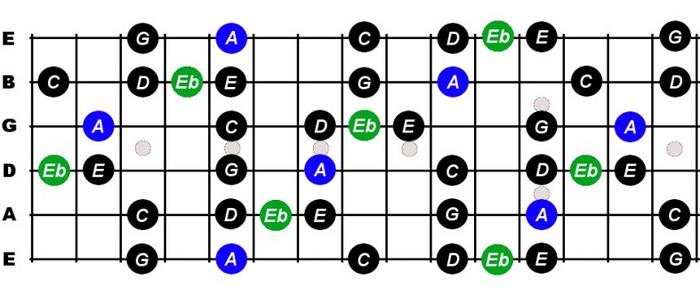
As we dive deeper into the application of the A minor blues scale, I invite you to explore how mastering the timing aspect can significantly enhance your blues performance. Is the scale primarily reserved for specific situations? Or can it be used more liberally to create that sought-after bluesy effect?
Interested in adding a bluesy twist to your performances? Let’s explore when to incorporate the A minor blues scale.
From my years as an experienced improviser, I’ve learned that there is no hard and fast rule about when to employ this scale. However, there are certain contexts in playing blues on guitar where it sings—where its unique combination of notes creates a mood that resonates deeply.
One ideal place to apply the A minor blues scale is in a 12-bar blues context. Let’s say you’re improvising over a 12-bar progression in A. During the I, IV, and V chords (in this case, A, D, and E), the notes of the scale can be used to generate those characteristic bluesy licks and riffs. It can provide the grit, the sorrow, the exuberance—those quintessential blues feelings. The same can be applied when the songs veer towards minor key blues, giving your performance a bolder, more poignant feel.
Alternatively, each time you’re playing a solo or melody line in A minor, consider weaving in elements of the A minor blues scale. It’s sure to add a strong bluesy flavor to your rendition, strengthening the overall vibe.
What I want to convey, as a fellow guitarist, is to constantly experiment with the A minor blues scale. Your unique style and creative choices play an essential role in determining the ‘when’ and ‘where’ of its application. Remember to treat these situations as starting points to explore, and not as restrictive rules.
As we proceed, let’s keep broadening our understanding and pushing our boundaries. I look forward to guiding you through the fascinating complexities of when and why to use the A minor blues scale for improvisation and soloing.
Why to use the A Minor Blues Scale for Improvisation and Soloing

Throughout my journey in mastering guitar improvisation, I’ve learnt ardent admiration and understanding for the A minor blues scale. The fierce beauty of the A minor blues scale, with its company of evocative tones and stark rawness, is nearly inimitable. Its resonance, in my hands as much as in my heart, guided my learnings at the New England Conservatory where I pursued a Master’s in Contemporary Improvisation.
And now, I am here to share with you why the A minor blues scale has the transformative power to elevate your improvisational skills and manifest magic in your solos. It’s time to peek into an enthralling world that unravels with this unique scale.
How can the A minor blues scale elevate your improvisational skills? Let’s delve into its unique characteristics and applications in solos.
Firstly, the A minor blues scale adds an emotive depth with its ‘blue’ note- the flattened fifth. This evokes an intoxicating charm, infusing your guitar improvisation with melancholy, longing and a distinctive edge. Used judiciously, this single note can be the defining moment in your solo, the point that captures the listener’s heart and cements your play in their memory.
Another element where the A minor blues scale shines is its versatility. It’s remarkably compatible with a range of harmonies. Thus, soloing with the blues scale becomes an expansive affair. From blues and rock to jazz and funk, this scale can effortlessly glide across genres, styles, and moods. It’s like having countless colors on your musical palette, each capable of bringing a new mood or texture to your composition.
Further, the A minor blues scale harbors an inherent tension due to its composition. This makes it a fantastic tool for improvisation, allowing you to experiment with tension and resolution, an integral part of any engaging musical narrative. The interplay between different notes in this scale can enhance your guitar solo techniques, making you a dynamic and expressive player.
Personally, the A minor blues scale allowed me to paint my musical landscapes with greater detail and emotion. It became a key tool in expressing my innermost feelings, experiences and stories. Learning and mastering it was like acquiring a new language – one that spoke directly to the heart.
In conclusion, the A minor blues scale isn’t merely a scale, it’s a powerful storyteller. It offers a deeper connection with your music, pushing the boundaries of your expression, making your improvisation more explorative, and your solos more captivating. Embrace it and let it transform the way you communicate through your guitar.
As we continue our guide, remember that the A minor blues scale, like any other aspect of music, is a means to an end; the ultimate goal being to create music that resonates and moves. Now, let’s move on to unlocking the intricacies of playing the A minor blues scale on the guitar and understand its dynamism beyond the theory.
How to Play the A Minor Blues Scale on Guitar
Learning the Scale Positions and Shapes
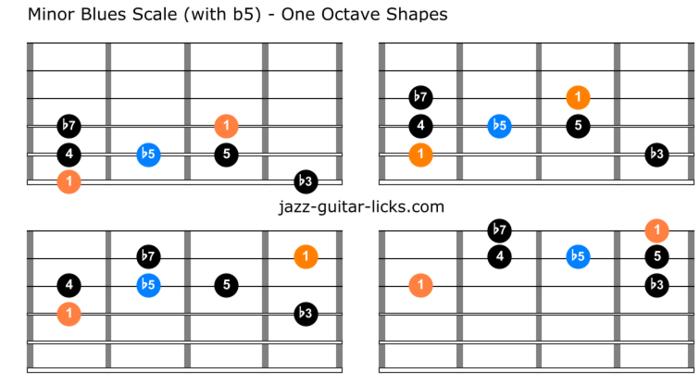
Now that we’ve established what the A minor blues scale is, its comparison to the A minor pentatonic scale, and where and when to use it, let’s delve into the practical application. As we move further into this guide, the ‘how’ aspect of our discussion becomes crucial. My expertise in guitar scale patterns and the CAGED system will be instrumental in guiding you through scale positions and shapes.
Understanding the blues scale positions is pivotal in knowing where to place your fingers on the fretboard. The scale we are exploring has five unique positions. Each blues scale position corresponds to a particular starting note, making it a repeating pattern across the fretboard. This enables a guitarist to play the same scale in various pitches. As we navigate through these positions, visualize them as interconnected shapes that form one seamless pattern.
The shapes, on the other hand, come into play through the CAGED system. This system provides a systematic way of navigating the fretboard by dividing it into five scale patterns – C, A, G, E and D. When learning the A minor blues scale, you’ll be playing in the ‘A’ position. This shape is conveniently memorable and easy to move around. The note played by your index finger is the root note of the scale, which is A in this case. Your understanding and mastery of this shape will help in enabling fluent improvisation and soloing.
Remember, learning guitar scale patterns and the CAGED system effectively is not an overnight process. It takes time, practice, and patience. By immersing yourself in the study and practical application of scale positions and shapes, you’ll ultimately find yourself achieving fluidity and ease while playing the A minor blues scale on your guitar.
Let’s now move forward to reading and following the tabs, another essential aspect of learning this musical form. By combining a theoretical understanding of scale positions and shapes with practical guidance through tabs, you can embark on an enriching journey of mastering the A minor blues scale on your guitar.
Reading and Following the Tabs
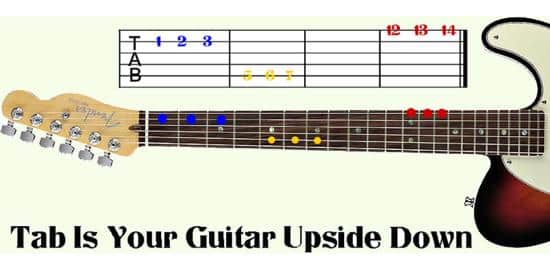
With a solid understanding of the A minor blues scale under your belt, it’s time to delve into the heart of the matter: reading and following the guitar tabs for scales. My extensive experience in transcribing music and crafting tabs across a broad spectrum of guitar music put me in a unique position to guide you through this essential step.
Tabs, short for tablatures, serve as a simplified way to read music, particularly equipped for string instruments like our beloved guitar. They translate complex traditional sheet music into easy-to-understand numerical forms. Consider them your roadmap, drawing out the course you’ll follow to articulate the heartrending nuances of the A minor blues scale.
In essence, guitar tabs indicate which fret to press on which string. For instance, ‘0’ signifies an open string, while ‘1’ shows you should press the first fret. Following them sequentially gives you the haunting, mournful tones that epitomize the minor blues scale.
Grasping how to effectively interpret these tabs is crucial in mastering the A minor blues scale on guitar. Like the galvanizing conversation between notes in a solo or the intricate lacework of an improvisation, they form an integral part of our guitar journey.
While tabs may appear uncomplicated, it’s vital not just to skim over them but to truly immerse yourself in them. Consider the tabs as something alive, not mere digits, but the essence of the scale expressing itself through you and your guitar.
Delving into the ‘how’ of it all, with time, I’ll proactively share examples of actual tabs, elaborating how each tab brings the A minor blues scale to life, helping you make effective use of the tabs in forming chords, or creating your own solos and improvisations. With careful observation and practice, soon enough, you will adeptly navigate through tablatures, playing the guitar like a seasoned pro.
In the next section, we’ll build on this foundation, focusing on some of the typical questions beginners have about the A minor blues scale on guitar. My aim is for you to gather comprehensive know-how to not just play but to truly feel each nuanced tone of the A minor blues scale.
FAQs
What is the A Minor Blues Scale?
How to start learning the A Minor Blues Scale?
How often should I practice A Minor Blues Scale?
Are there any exercises that can help with the A Minor Blues Scale?
Conclusion
Ready to wrap up our deep dive into the A minor blues scale? Join me as we summarize and nuance our newly acquired knowledge! Having journeyed together through the art of playing blues on guitar, I trust you are equipped to confidently use this music staple. It all starts with understanding the A minor blues scale in contrast to the A minor pentatonic scale and knowing where to apply it on the guitar fretboard.
The richness and versatility of the A minor blues scale shine when used in blues improvisation and soloing, making it a crucial tool to learn. We’ve decoded the process of learning the scale positions and shapes, while emphasizing the importance of reading and following tabs. In mastering these fundamentals, you will find navigating any guitar scales an easier, more enjoyable process.
As we wrap up this comprehensive guide, allow me to reiterate the significance of the A minor blues scale in your journey as a guitarist. Remember to be patient with yourself as you learn, practice and experiment. You are embracing a new form of expression, adding another tonal colour to your musical canvas. My years immersed in the world of guitar have taught me the immense value in this.
I hope this guide has been instrumental in helping you connect with the soulful allure of the blues, adding depth to your guitar playing experience. Keep strumming and discovering!
